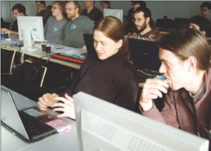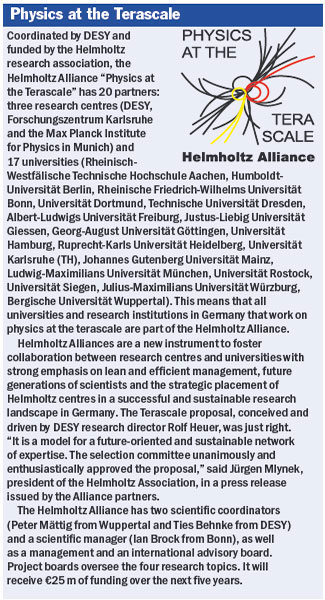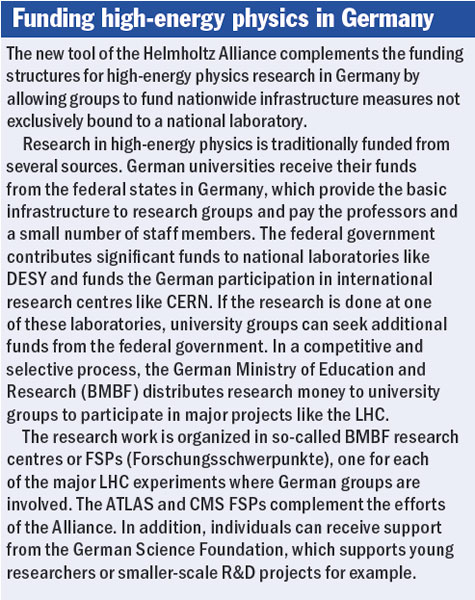The next big advances in particle physics are expected to happen at the “terascale”. The tremendous complexity and size of experiments at the LHC and the proposed International Linear Collider (ILC) challenge the way that physicists have traditionally worked in high-energy physics. The German project Physics at the Terascale – a Helmholtz Alliance that will receive €25 m over five years from Germany’s largest organization of research centres, the Helmholtz Association – will address these challenges.

Credit: Helmholtz Alliance.
The Alliance bundles and enhances resources at 17 German universities, two Helmholtz Centres (the Forschungszentrum Karlsruhe and DESY) and at the Max Planck Institute for Physics in Munich. It focuses on the creation of a first-class research infrastructure and complements the existing funding mechanisms in Germany at local and federal level. With the help of the new project, central infrastructures are developed and are shared among all Alliance members. The Alliance will fund many of these measures for the first few years. From the beginning, a central point of the proposal has been that the long-term future of these activities is guaranteed by the universities and the research centres beyond the running period of the Alliance funds.

Credit: DESY.
See pictures: School 1 and School 2.
The Alliance supports four well defined research topics (physics analysis, Grid computing, detector science and accelerators) and a number of central “backbone” activities, such as fellowships, interim professorships, communication and management.
Close-knit infrastructure
What is new about this common infrastructure? Previously, each of these institutes developed their infrastructure and expertise for their own purposes. Now, triggered by the Alliance, different institutes share their resources. Common infrastructures are developed and are made available to all physicists in Germany working on terascale physics. For example, this means that if PhD student Jenny Boek of Wuppertal wants to develop a chip for slow controls, she can now use the infrastructure and take advantage of the expertise in chip design in Bonn.
These central infrastructures can be concrete installations – like a chip development and design laboratory, located at a specific location – or virtual ones, like the National Analysis Facility, which will help all LHC groups in Germany to participate more efficiently in the analysis of data from the LHC. Common to all of these is that these infrastructures are open to all members of the Alliance, and are initially funded through it.

An important goal of the Alliance is to organize interactions between the different experimental groups and between the experiment and theory communities on all topics of interest for physics analysis at the terascale. This includes meetings and the formation of working groups with members from all interested communities, the organization of schools and other common activities. It can also mean basic services, such as the design and maintenance of Monte Carlo generators, or include exchanges on the underlying theoretical models. In all of these studies, while the focus is initially on the LHC, the role of the ILC will also feature as a future facility of key importance in the field.

In the same spirit, Alliance funds are used to improve the Grid infrastructure significantly in Germany, to serve the global computing needs of the LHC as well as the specific requirements of German physicists to contribute to the data analysis. Funds are provided to supplement the existing Tier-2 structure in Germany by building up Tier-2s at several universities, and to support the National Analysis Facility at DESY. Additional money is provided to allow for significant contributions to improve Grid technologies with the emphasis on making the Grid easier for the general user.
The third research topic, detector development, involves plans for the future beyond the immediate data flow from the LHC. Institutes are already developing next-generation detectors for the ILC and for LHC upgrades. A Virtual Laboratory for Detector Development will provide central infrastructures to support the different groups for these projects. A number of universities and DESY are setting up infrastructures with special emphasis on chip design, irradiation facilities, test beams and engineering support. Again, although these facilities are at specific locations, they serve the whole community.
Fostering young talent
The Alliance also wants to increase the involvement of universities in accelerator research in Germany. Through a number of programmes – for example a school for students on accelerator science or lectures at universities – the Alliance tries to increase the involvement of universities in accelerator research over the long term. Rolf Heuer of DESY, one of the initiators of the project, explains the motivation: “Germany led the way to the TESLA technology collaboration and its success, and we want to stay at the forefront of accelerator development. Without it, progress in many areas of science will not be possible.”
A substantial part of the Alliance’s funding goes into the creation of more than 50 positions for young scientists and engineers all over Germany. The five Alliance Young Investigators groups and the Alliance fellowships play a special role: they are supposed to attract young physics talents from all over the world to Germany and to the terascale. Many of these positions are tenure-track, something quite rare in Germany. In addition, positions are created to support the infrastructure activities, to set up the central tasks and support the work of the Alliance. More than 250 people have already applied for the new positions over the last eight months.
A significant fraction of the accepted applications are from women. This is in accordance with the Alliance’s aim to enhance the role of women in physics. One way to attract smart and ambitious young people to the German research landscape is the dual career option – the Alliance pays half a salary for the partner to work at the same institution. So when Karina Williams, now in the final year of her particle physics phenomenology PhD at Durham University in the UK, applied for postdoctorate positions, she made sure that the places where she applied would also have a job for her partner. It worked out at Bonn University, where she and her partner start later this year. “I think it’s wonderful that schemes like this exist,” she says. “I know so many people who have either had to put up with very long-distance relationships or left the subject because their partner could not get a job nearby. When I first started applying for jobs, I was told that long-distance relationships were just part of the postdoc life.”
Centralized community
DESY plays a special role within the Alliance. It provides unique and basic infrastructures for accelerator research, as well as large-scale engineering support for detector research. This is a tradition that goes back to when DESY ran accelerators for high-energy physics. A new role for DESY is to host central services for the German physics community to support physics analysis in Germany. One of these services is the Analysis Centre, where research will focus on areas of general interest, which are often emphasised less at universities. Examples of these topics are statistical tools or parton distribution functions, where the Alliance will profit from the outstanding expertise at DESY from HERA. Of course it is not only R&D that researchers at the Analysis Centre will pursue; another purpose is to form a kind of helpdesk to answer questions and offer help in organizing topical workshops. Expanding on its role as an LHC Tier-2 centre, DESY is also setting up the National Analysis Facility, a large-scale computer installation to support the user analysis of LHC data. The first processors are already installed in DESY’s computing centre, providing fast computing power for efficient analyses by German LHC groups.

Another example of “central services” – like Alliance fellowships, equal opportunity measures or dual career options – is a “scientist replacement” programme. The goal of scientist replacement is to enable senior professors to take up roles of responsibility at the LHC experiments by sponsoring junior professors to replace them at university. Karl Jakobs is physics coordinator at ATLAS and a part-time bachelor. His home and family are in Freiburg in southern Germany, but he has had a flat in Saint Genis-Pouilly near CERN since October last year and a great deal of long-term responsibility within the experiment – something that would have been impossible less than a year ago. Now the Alliance is funding his replacement in Freiburg. In this way, German particle physicists can play leading roles in current and future experiments more easily. This may sound like a trivial thing – but all German professors are obliged both to do research and to teach, binding them to their university and only releasing them during breaks and the occasional half-year sabbatical. Jakobs’ classes are currently, until the end of the summer, being taught by Philip Bechtle from DESY. Another example is Ian Brock, scientific manager of the Alliance, whose replacement during his leave of absence from Bonn University is paid for and provided by the Alliance.

The Alliance was officially approved in May last year, funding started in July, and it is already a prominent part of the German landscape of particle physics. It had an impressive start and most of the structures of the Alliance have begun working intensively. A major event was the “kick-off” workshop at DESY in December. With 354 registered participants (many of them undergraduate, graduate and PhD students), a large part of the German high-energy physics community was there. The workshop proved a great opportunity for young particle physicists to get to know each other and exchange ideas: Terascale gives them a backbone structure that they will now fill with content.
The Alliance is already changing the way particle physics is done in Germany. The main idea is to establish cooperation among the different pillars of German research in particle physics. Expertise, which is scattered around many different places, is being combined to become more efficient. As Heuer explains: “The Alliance strengthens R&D on LHC physics in Germany, pushes for accelerator physics and prepares for the ILC. It is our hope that this helps in the worldwide effort to unravel the basic structure of matter and to understand how the universe has developed.”
Jakobs, meanwhile, is happy to benefit from the arrangement at CERN. “Everything is happening here. You cannot be physics coordinator and not be stationed at CERN. There are regular meetings, you talk to people all the time, watch their progress and coordinate to optimize.” As physics coordinator he has to make sure that all ATLAS people who work on Higgs analysis and other special topics work together in a coherent way. There is a complicated sub-group structure and all simulations and data have to be perfectly understood. “The good thing is that after my job here, I will be able to return to Freiburg with a clear conscience and spend a lot of time analysing the data I helped to prepare,” he explains. “Administration, teaching, funding proposals, forms and management – all that takes time at home. It is a great luxury to be able to concentrate on one thing only here: pure physics.
• For more information about Physics at the Terascale, see www.terascale.de.
• For further information about the Helmholtz research association, see www.helmholtz.de/en





